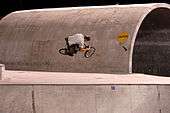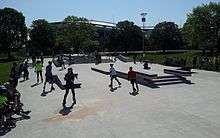List of skateparks
Builders of skateparks include local skateboarders creating do it yourself / "barge board" parks. And some firms, including SITE Design Group, of Solana Beach, California, which asserts having designed more than 100.
This is a list of notable skateparks.
The first skatepark to receive historic designation was the Bro Bowl, in Florida, listed in the National Register of Historic Places. The second was The Rom, in east London, England, which is Grade II listed.
Australia
- Bill Godfrey Oval
- City Sk8 Park, Adelaide
- Monster Skatepark, Sydney Olympic Park
- Pizzey Park
- Snake Run
- West Beach Skate Park
Canada
- Legacy Skatepark, Ottawa's largest at 18,300 square feet (1,700 m2)
- Underpass Park, Toronto
- Vancouver Skate Plaza, Vancouver, once named 21st on a top-25 list of world's best skate parks
- Shaw Millennium Skatepark (Calgary, Alberta, Canada) – One of the world's largest outdoor skateparks, designed by Spectrum Skateparks with Landplan associates.
Denmark
- Copenhagen Skatepark, Copenhagen
France
- Beton Hurlant, Paris, from the 70s[1]
- La Villette, Paris, from the 70s[1]
- Prime Paris, Paris, from the 70s[1]
- Erromardie, Saint-Jean-de-Luz, from the 70s[1]
- Saintes skatepark, Saintes, from the 70s, still open in 2019[1] From 1978?,[2] at Skateparks.fr
- La Roche-sur-Yon skatepark, La Roche-sur-Yon, from the 70s, still open in 2019[1]
- Lorient skatepark, Lorient, from the 70s, still open in 2019[1]
There are numerous current skateparks listed at skateparks.fr.
See also: Skatepark, in French-language Wikipedia
Germany
- Mellowpark, Berlin
Jordan
- 7Hills Skatepark, Amman
Malaysia
Pasir Gudang Skate Park in Johor, Malaysia.
Netherlands
- Area 51 (skatepark), Eindhoven. One of largest in Europe.
North Korea
- Pyongyang Skatepark, the first skatepark in North Korea.
Philippines
- Koronodal Skate Park in Koronadal, Cotabato[3]
- Tagaytay Extreme Sports Complex in Tagaytay, Cavite. The venue for skateboarding at the 2019 Southeast Asian Games.[4]
Serbia
- Bor Skate Plaza, in Bor. Largest skate park in the Balkans.
Slovenia
- Skate park Rog ("Skejt park Rog") – the first covered skate park in Slovenia, at Rog (factory)
Sweden
- Stapelbäddsparken in Malmö.
United Kingdom
- The Buszy
- Harrow Skate Park – Harrow, UK
- Radlands
- Rampworx skatepark, Liverpool. The largest indoor venue in the UK, covering 50,000 square feet (4,600 m2).
- The Rom (1978), Grade II listed skatepark in Hornchurch, east London, England.
- Stockwell Skatepark – South London, UK
United States
Arizona
California
- Carlsbad Skatepark (1976), Carlsbad. California's first skatepark. Home of World Skateboard Championships on April 10, 1977. Operated until 1979, then buried, then destroyed in 2005.[5] The current Carlsbad Skatepark is elsewhere.[7]
- Pier Avenue Junior High School skatepark (1999), Hermosa Beach. Opened by the city, a small skatepark at the site of the first skateboard competition, which was organized by Dewey Weber across the street from his surf and skateboard shop. Makaha Skateboards was a sponsor of the competition.[8] School is now a museum.
- etnies Skatepark, Lake Forest – Largest free skatepark in California.[9] 62,000 square feet (5,800 m2).
- Pedlow Skate Park – Encino, California great for pool skating, more than 12,000 square feet (1,100 m2).
- Santa Maria Skate Park – Fletcher Park. 700 Southside Pkwy, Santa Maria, California.
- The Palm Springs Skatepark contains a replica of the Nude Bowl, which is the most popular feature in the park.[10]
Connecticut
- CT Bike (1987), Bristol, Connecticut. All wooden indoor skate park, still in business today, despite a 1988 fire, operated by same family. Where Tony Hawk "made his debut when he was just a young boy on his first East Coast tour."
Florida
- Kona Skatepark in Jacksonville, Florida. One of few private parks of the 1970s surviving.[11]
- Bro Bowl – One of the last skateparks of the 70s, and one of the oldest skateparks in the U.S.; First public skatepark in Florida Tampa, Florida. Listed on the National Register of Historic Places
- Possum Creek – Gainesville, Florida.
- Skatepark of Tampa – Skatepark in Tampa and home of the annual Tampa Pro.
Kentucky
- Louisville Extreme Park – Louisville, Kentucky.
Maryland
- Ocean Bowl Skate Park (1976), Ocean City, Maryland, first on East Coast, and oldest operating municipal skate park in the United States. Renovated/rebuilt in 1997–98.[12]
New Mexico
New York
Ohio
- Skatopia – Anarchist Skatepark in Rutland, Ohio
- The Flow Skatepark (2001-2013), Columbus. Was a world-famous[1] skatepark. At approximately 50,000 square feet (4,600 m2), The Flow was one of the largest indoor skateparks in the nation. It was voted #1 skatepark in the United States by Fuel TV.
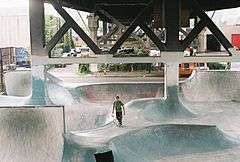
Oregon
- Burnside Skatepark, a do it yourself "barge build" beneath the Burnside Bridge in Portland, Oregon. The modern skatepark designs of the Pacific Northwest can be traced back to this. Skateboarders used an area populated primarily by the city's "undesirable elements" to create a skatepark, building one section at a time. The process is called "design/build" (D/B), and is a characteristic of many skateparks today. The design/build process ensures that adjacent skatepark features are harmonious and rideable, allowing skateboarders to create endless "lines" to ride among the many features.
- Burnside Skatepark, Portland, Oregon featured in Tony Hawk video games and the movie Paranoid Park.
- Ashland Skate Park (1999[13]), Ashland. It's a "rad and versatile" park.[13] It was amidst some contention about families and surveillance cameras in 2018.[14] Which led to a camera has been set up. This may be a time-lapse film recording from today?
Pennsylvania
- FDR Skatepark – Philadelphia, Pennsylvania
Tennessee
- Concrete Wave Country – Nashville's first public skatepark.
Texas
- Lee and Joe Jamail Skatepark – 30,000-square-foot (2,800 m2) in-ground public facility in Houston, Texas.
Virginia
Mount Trashmore Skatepark, in Virginia Beach, may be the most famous. With 24,000 square feet (2,200 m2), it is not the largest skatepark in the state.
Washington
- A skatepark (1966), Kelso, Washington. For skateboarders and skaters, with plywood ramps, lighted for night use.[15]
Wisconsin
- Turf Skatepark (1979), Milwaukee. Included five concrete pools in an indoor/outdoor facility (defunct since 1996).
- to be processed
In more extreme climates, parks were built indoors, often using wood or metal. By the end of the 1970s, the popularity of skateboarding had waned, and the original parks of the era began to close. A downturn in the overall skateboard market in the 1980s, coupled with high liability insurance premiums, contributed to the demise of the first wave of skateparks. Some second-generation parks, such as Upland, California's Pipeline, survived into the 1980s. However, many public parks of that era can still be found throughout Western Europe, Australia and New Zealand.
Gallery of Skateparks
- Many more in Category:Skateparks yet to be processed
References
- 1970s Skateparks
- Saintes
- Rivera, Oliver Ross (15 January 2020). "Koronadal City goes extreme with newly-built skatepark FEATURE Koronadal City goes extreme with newly-built skatepark". Philippine Information Agency. Retrieved 20 January 2020.
- "Tagaytay Extreme Sports Complex covered in ash". Rappler. 13 January 2020. Retrieved 20 January 2020.
- McAlister, Mike. "Concrete Skatepark Tour – Candid". preview.arraythemes.com.
- “Surfing – Tucson Style”, Tucson Daily Citizen, September 2, 1965
- "Carlsbad Skatepark Update 5-20-05", "Archived copy". Archived from the original on 2010-01-11. Retrieved 2010-04-29.CS1 maint: archived copy as title (link)
- "HB rode into skateboarding history", http://www.dailybreeze.com Archived 2005-07-09 at the Wayback Machine, 27 June 2004
- "Etnies Skatepark Of Lake Forest Aerial". Archived from the original on 10 March 2010. Retrieved 21 August 2010.
- "City of Palm Springs – Skate Park". Ci.palm-springs.ca.us. Archived from the original on 2010-05-14. Retrieved 2010-05-07.
- Matt Soergel (July 1, 2007). "KONA". The Florida Times-Union. Archived from the original on October 9, 2012. Retrieved August 18, 2011.
- "History". oceancitymd.gov. Archived from the original on 28 December 2017. Retrieved 4 May 2018.
- "Ashland (Oregon)". SkateOregon. Retrieved November 23, 2019.
- John Darling (July 19, 2018). "Families steer clear of Ashland Skate Park". Mail Tribune.
- Popular Science Magazine, April 1966, p127
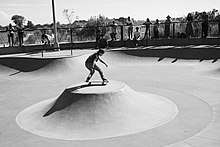
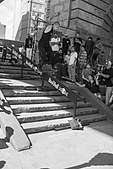
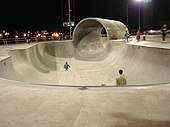
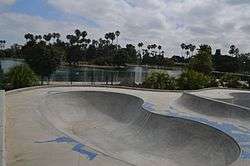


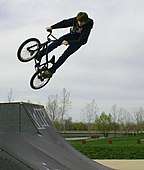


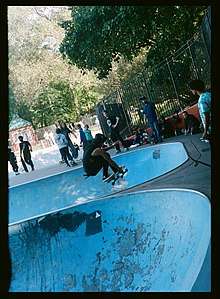

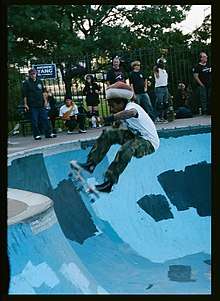
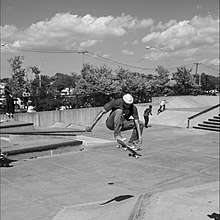
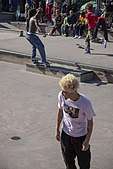
.jpg)

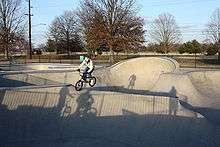

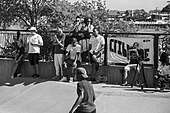
_pic.a3320.jpg)
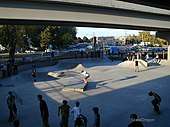
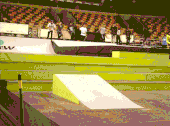
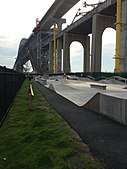
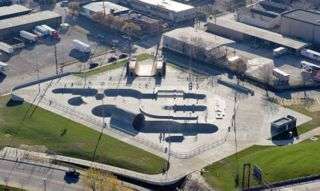
.jpg)

